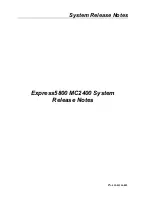
4-38 Installing the Operating System and Utilities
ESMPRO
ESMPRO lets a system administrator manage remote servers across a network. ESMPRO
monitors server hardware and software configurations, failures, and performance. With log data
collected by ESMPRO, a system administrator can track long-term and short-term performance,
monitor server usage, create graphs to record trends, and check server failure rates. The
administrator can use the information collected to create more efficient data routing procedures and
optimize server usage.
NOTE:
For detailed explanation on ESMPRO, refer to the online document
in the EXPRESSBUILDER CD-ROM.
Functions and Features
ESMPRO offers many functions and features for managing remote servers across a network.
These features help the system administrator perform daily system operation, system extension,
and transfer tasks. The features of ESMPRO Manager include:
!
Hardware and software server configuration
– Hardware resources mounted in servers, such as the CPU, memory, disks, disk arrays,
and LAN boards.
– Software resources, such as operating system information and drivers running on each
server.
!
Server failures
– On-screen real-time displays provide the system administrator with the failure type,
location, cause, and suggested corrective action.
– Failure data includes hardware failure information such as system board temperature,
memory failure, crashes, and software failure information.
!
Performance
– ESMPRO monitors server performance, displays server usage on the screen and useful
information, such as the rate of CPU load, memory usage, disk usage, and LAN traffic.
Usage threshold values can help the system administrator monitor and prevent server
overloads.
Summary of Contents for EXPRESS5800/120MF
Page 1: ... EXPRESS5800 120Mf U s e r s G u i d e ...
Page 2: ......
Page 4: ......
Page 12: ...x ...
Page 24: ...1 6 System Overview Rear View 11 9 10 12 13 14 15 16 2 17 15 18 17 16 1 8 7 6 1 2 3 4 5 2 5 1 ...
Page 58: ...1 40 System Overview This page is intentionally left blank ...
Page 59: ...Chapter 2 Setting Up Your Server This chapter describes how to set up your server ...
Page 202: ...4 62 Installing the Operating System and Utilities This page is intentionally left blank ...
Page 214: ...5 12 Maintenance This page is intentionally left blank ...
Page 229: ...Troubleshooting 6 15 Memory modules DIMM Group 3 DIMM Group 2 DIMM Group 1 ...
Page 304: ...7 50 Upgrading your Server This page is intentionally left blank ...
Page 305: ...Chapter 8 Internal Cabling Diagrams Internal cable connections of the server are shown below ...
Page 318: ...B 4 IRQ and I O Port Address This page is intentionally left blank ...
Page 326: ...C 8 Installing Windows 2000 This page is intentionally left blank ...
Page 340: ...10 Glossary This page is intentionally left blank ...
Page 345: ...xx ...
Page 346: ... ...
















































